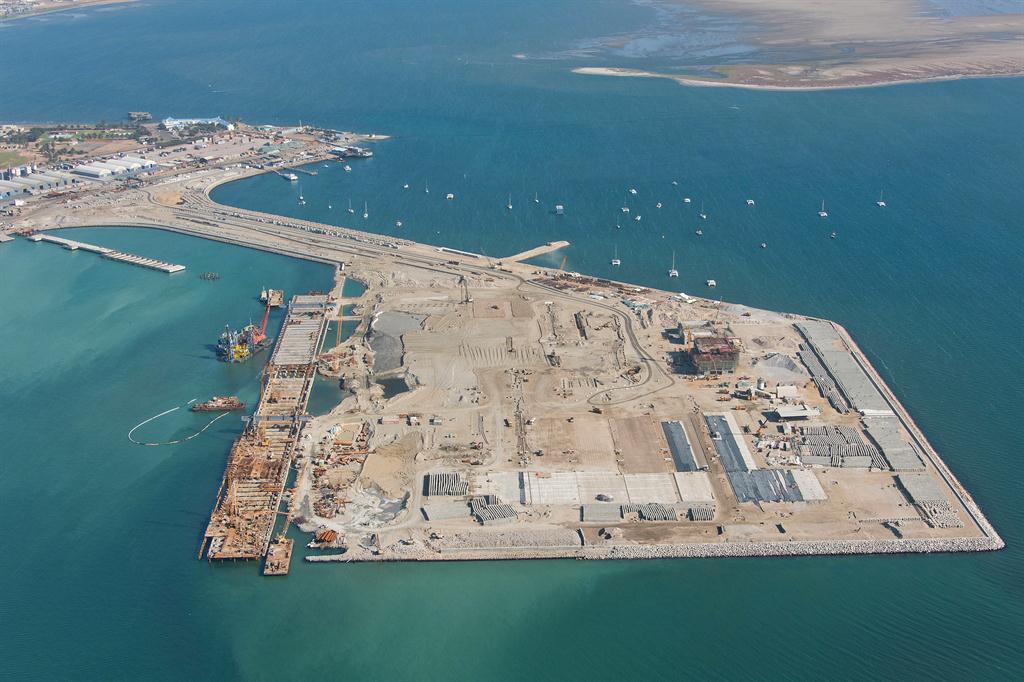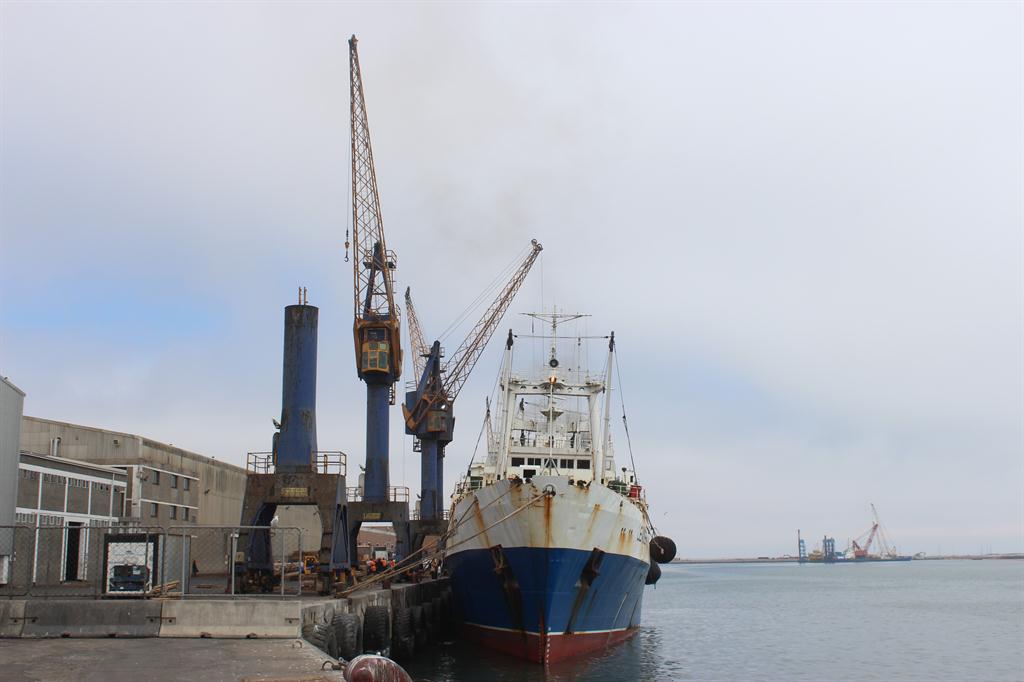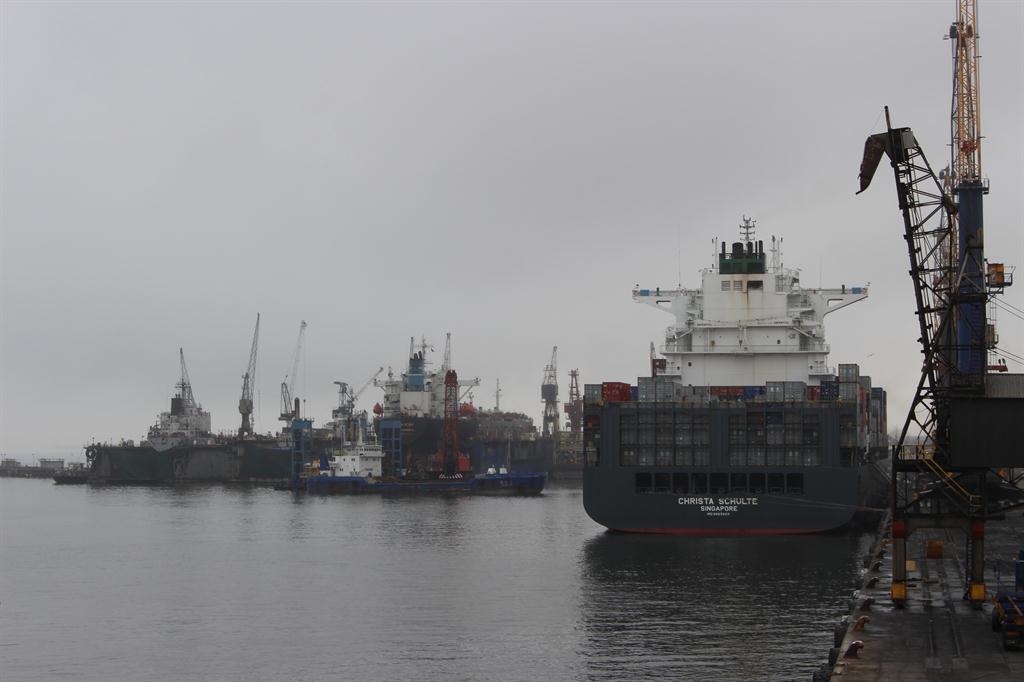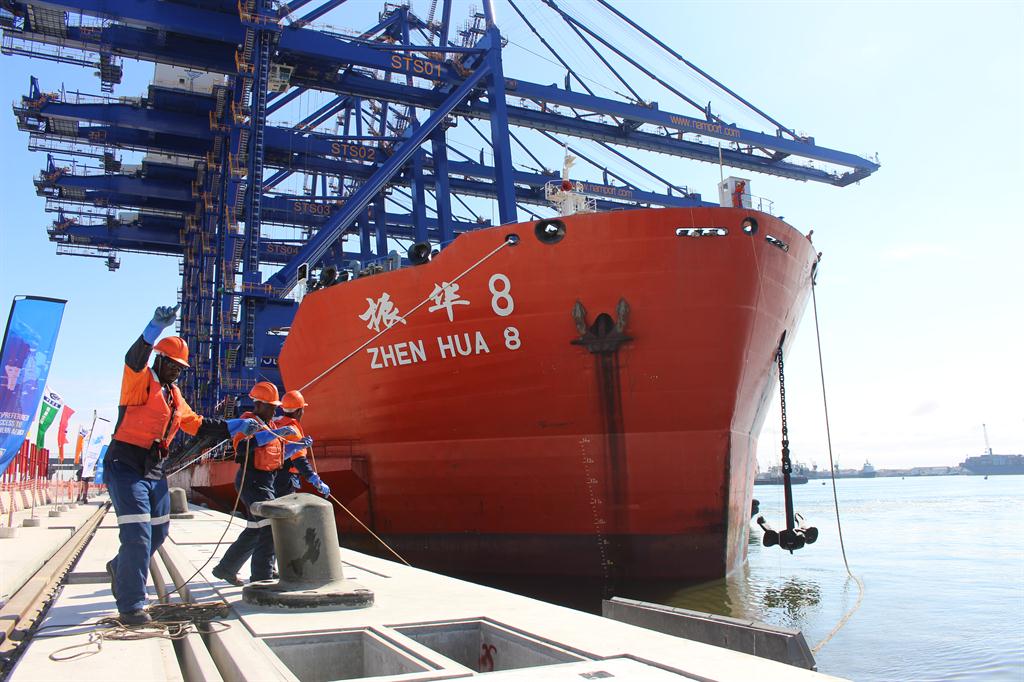Namport: Full steam ahead
The Walvis Bay Port is preparing to handle increased volumes of cars and containers.
Augetto Graig - The port of Walvis Bay is leading the way to achieve Namibia’s ambition of becoming a transport and logistics hub for Southern Africa.
While the country slugs through the quagmire of government’s austerity measures, global commodity price slumps and economic slow-down, Namport has steamed ahead achieving significant milestones.
Combined volumes of cargo landed at both Walvis Bay and Lüderitz have increased from 2,7 million tons to 3,4 million tons between 2009 and March of 2017, peaking between 2014 and 2015 at 3,7 millon tons. Cargo shipped through the ports weighed 1,4 million tons in 2009 and 1,5 million tons in 2015 but peaked in 2011 at 1,7 million tons.
Cargo trans-shipped dropped from little more than 1 million tons in 2009 to 573 000 tons in 2016 after reaching 1,5 million tons in 2010. Total cargo handled was 5,5 million tons in 2016/2017, according to port records.
Much of that cargo comes in containers which are easily loaded onto trucks or train carriages for further distribution. In the 2015/2017 reporting period 205 991 cargo containers were handled at the two ports, less than the 256 319 dealt with in 2009 and less than the peak in 2010 when 337 134 went through the pair of ports.
FOCUS ON WALVIS BAY
Both Walvis Bay and Lüderitz ports are running smoothly, but it is at Walvis Bay that this state owned enterprise shows what a parastatal can do, and what efficiency and effectiveness in this sphere can mean to a country’s development. Walvis Bay is the point of destination for freight coming to Southern Africa from all over the world, and for many of the region’s exports to the global market.
The Walvis Bay port is committed to increasing its capacity and eagerly awaits completion of a new container handling facility which will provide space for up to 750 000 containers per year. According to Namport corporate communication manager Taná Pesat, the Container Terminal will be complete by mid-2019 as the facility reached the 85% completion mark in January 2018. Namport executive for Ports Authority, Mr Elzevir Gelderbloem, is the project manager of the new Container Terminal. “We do not except container volumes to jump overnight when we commission the new container terminal. This will be a gradual ramp up process over a number of years. As volumes grow, so will the requirement for new jobs,” he said. Anticipating increased imports and exports of motorcars and commercial vehicles, Namport has identified land to store up to 3 500 units. Namport CEO Bisey /Uirab expects more foreign vessels to visit Walvis Bay in the future, necessitating expansion.
228 VEHICLES IN ONE GO
The arrival of the Grand Orion roll-on/roll-off vessel in May 2018 brought 418 motor vehicles through the port at once. The giant vessel can carry 59 217 gross tons and brought 228 sedan and 4x4 bakkies with 173 trucks of which only 8 were destined for the local market. Of the automobiles 89 were destined for Zambia, 57 for Zimbabwe, 16 for Botswana, 42 for Malawi and six for the Congo.
Between 2 000 and 2 250 vessels visit Walvis Bay annually.
The need to increase capacity and improve efficiency through infrastructure development resulted in the erection of four new Ship to Shore (STS) cranes. At a combined cost of N$440 million the cranes each stand 80 meters tall.
Walvis Bay also sports the Syncrolift as part of the vessel repair facility, which can lift up to 2 000 ton vessels. The three Panamax floating docks at the harbour can lift a total of 29 500 metric tons combined.
MAJOR FREIGHT
Fuel imports to the country come through Walvis Bay while fish products, copper, lead, marble and granite are among the exports. Salt is the largest volume export, with one consignment in January 2018 measuring 50 000 tons.
Another significant export was lithium concentrate exported to China, before international lithium prices fell too low to sustain continued production. Nevertheless demand is expected to increase fourfold by 2025 and price recovery is awaited eagerly.
Significant imports through Walvis Bay this year include 40 000 cement clinkers for Cheetah Cement delivered in February by the MV Magnum Power, entailing 20 days of offloading onto trucks for delivery at the new cement plant outside Otjiwarongo.
Equipment and machinery for the new Peugeot automotive assembly plant being built in Walvis Bay arrived at the port in June and have been taken to the Nara Investment Park which will house the plant.
Two transformers worth N$40 million and weighing 142 ton each came from India and have been transported to Nampower’s Ruacana hydroelectric power-station.
In June 3 336 tons of construction equipment and supplies came through Walvis Bay from China, for construction of the Kafulafuta water treatment plant in Ndola, Zambia. The dry port facility created by the memorandum of understanding signed with Zambia in 2007 was instrumental to that consignment, and similar facilities for other countries are being investigated.
SPECIAL ASSIGNMENTS
Walvis also sees special cargo assignments like the 205 live animals sent on the El Nino to die Democratic Republic of the Congo in May. The wildlife including Nyala, Eland, Impala, Hartebeest, Oryx and Waterbuck were caught in Namibia while the Blesbuck in the consignment came from South Africa.
Such achievements are a source of pride of the CEO who launched the Walvis port’s “My Port, My Pride” campaign in March this year. He is also very excited about the port authority being chosen to roll out and operationalize the electronic national single window project, which dovetails with its own port automation programme.
Namport has established a subsidiary company, Namibia e-Trade Services, to manage and operate the single window, with a view to entering into a strategic alliance with a technical partner who will bring to the table experience and expertise in such an operation, he says.
/Uirab told port users at the annual dinner in September that both automation and the single window are gaining momentum, and catapulting Namport into being a major digital workplace. “This automation of manual trade processes will reduce the time it takes to clear goods which will have a positive impact on costs and time in the supply chain. So it is a real game changer for trade and economic prosperity and will, and is receiving priority attention from Namport. We are certain that it will significantly improve Namibia’s global competitiveness and port efficiency ratings as well as contribute to the success of the Namibia Logistics Hub,” he said.
While the country slugs through the quagmire of government’s austerity measures, global commodity price slumps and economic slow-down, Namport has steamed ahead achieving significant milestones.
Combined volumes of cargo landed at both Walvis Bay and Lüderitz have increased from 2,7 million tons to 3,4 million tons between 2009 and March of 2017, peaking between 2014 and 2015 at 3,7 millon tons. Cargo shipped through the ports weighed 1,4 million tons in 2009 and 1,5 million tons in 2015 but peaked in 2011 at 1,7 million tons.
Cargo trans-shipped dropped from little more than 1 million tons in 2009 to 573 000 tons in 2016 after reaching 1,5 million tons in 2010. Total cargo handled was 5,5 million tons in 2016/2017, according to port records.
Much of that cargo comes in containers which are easily loaded onto trucks or train carriages for further distribution. In the 2015/2017 reporting period 205 991 cargo containers were handled at the two ports, less than the 256 319 dealt with in 2009 and less than the peak in 2010 when 337 134 went through the pair of ports.
FOCUS ON WALVIS BAY
Both Walvis Bay and Lüderitz ports are running smoothly, but it is at Walvis Bay that this state owned enterprise shows what a parastatal can do, and what efficiency and effectiveness in this sphere can mean to a country’s development. Walvis Bay is the point of destination for freight coming to Southern Africa from all over the world, and for many of the region’s exports to the global market.
The Walvis Bay port is committed to increasing its capacity and eagerly awaits completion of a new container handling facility which will provide space for up to 750 000 containers per year. According to Namport corporate communication manager Taná Pesat, the Container Terminal will be complete by mid-2019 as the facility reached the 85% completion mark in January 2018. Namport executive for Ports Authority, Mr Elzevir Gelderbloem, is the project manager of the new Container Terminal. “We do not except container volumes to jump overnight when we commission the new container terminal. This will be a gradual ramp up process over a number of years. As volumes grow, so will the requirement for new jobs,” he said. Anticipating increased imports and exports of motorcars and commercial vehicles, Namport has identified land to store up to 3 500 units. Namport CEO Bisey /Uirab expects more foreign vessels to visit Walvis Bay in the future, necessitating expansion.
228 VEHICLES IN ONE GO
The arrival of the Grand Orion roll-on/roll-off vessel in May 2018 brought 418 motor vehicles through the port at once. The giant vessel can carry 59 217 gross tons and brought 228 sedan and 4x4 bakkies with 173 trucks of which only 8 were destined for the local market. Of the automobiles 89 were destined for Zambia, 57 for Zimbabwe, 16 for Botswana, 42 for Malawi and six for the Congo.
Between 2 000 and 2 250 vessels visit Walvis Bay annually.
The need to increase capacity and improve efficiency through infrastructure development resulted in the erection of four new Ship to Shore (STS) cranes. At a combined cost of N$440 million the cranes each stand 80 meters tall.
Walvis Bay also sports the Syncrolift as part of the vessel repair facility, which can lift up to 2 000 ton vessels. The three Panamax floating docks at the harbour can lift a total of 29 500 metric tons combined.
MAJOR FREIGHT
Fuel imports to the country come through Walvis Bay while fish products, copper, lead, marble and granite are among the exports. Salt is the largest volume export, with one consignment in January 2018 measuring 50 000 tons.
Another significant export was lithium concentrate exported to China, before international lithium prices fell too low to sustain continued production. Nevertheless demand is expected to increase fourfold by 2025 and price recovery is awaited eagerly.
Significant imports through Walvis Bay this year include 40 000 cement clinkers for Cheetah Cement delivered in February by the MV Magnum Power, entailing 20 days of offloading onto trucks for delivery at the new cement plant outside Otjiwarongo.
Equipment and machinery for the new Peugeot automotive assembly plant being built in Walvis Bay arrived at the port in June and have been taken to the Nara Investment Park which will house the plant.
Two transformers worth N$40 million and weighing 142 ton each came from India and have been transported to Nampower’s Ruacana hydroelectric power-station.
In June 3 336 tons of construction equipment and supplies came through Walvis Bay from China, for construction of the Kafulafuta water treatment plant in Ndola, Zambia. The dry port facility created by the memorandum of understanding signed with Zambia in 2007 was instrumental to that consignment, and similar facilities for other countries are being investigated.
SPECIAL ASSIGNMENTS
Walvis also sees special cargo assignments like the 205 live animals sent on the El Nino to die Democratic Republic of the Congo in May. The wildlife including Nyala, Eland, Impala, Hartebeest, Oryx and Waterbuck were caught in Namibia while the Blesbuck in the consignment came from South Africa.
Such achievements are a source of pride of the CEO who launched the Walvis port’s “My Port, My Pride” campaign in March this year. He is also very excited about the port authority being chosen to roll out and operationalize the electronic national single window project, which dovetails with its own port automation programme.
Namport has established a subsidiary company, Namibia e-Trade Services, to manage and operate the single window, with a view to entering into a strategic alliance with a technical partner who will bring to the table experience and expertise in such an operation, he says.
/Uirab told port users at the annual dinner in September that both automation and the single window are gaining momentum, and catapulting Namport into being a major digital workplace. “This automation of manual trade processes will reduce the time it takes to clear goods which will have a positive impact on costs and time in the supply chain. So it is a real game changer for trade and economic prosperity and will, and is receiving priority attention from Namport. We are certain that it will significantly improve Namibia’s global competitiveness and port efficiency ratings as well as contribute to the success of the Namibia Logistics Hub,” he said.









Comments
Namibian Sun
No comments have been left on this article